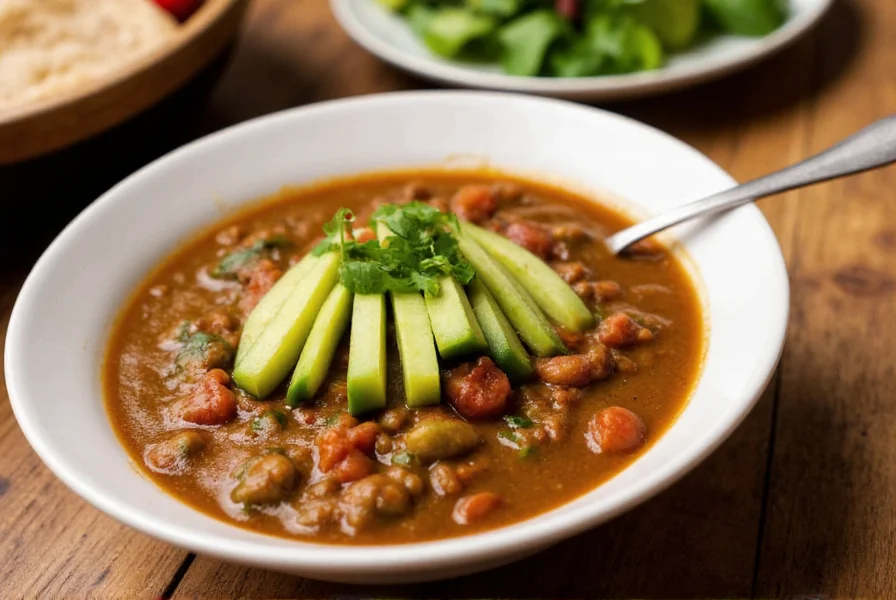The most authentic chili verde recipe features roasted tomatillos as the base, fresh serrano peppers, pork shoulder, cilantro, and Mexican oregano—never green tomatoes or flour-based thickeners. Traditional preparation involves roasting ingredients separately before simmering for 2-3 hours to develop complex flavors.
For centuries, authentic chili verde has been a cornerstone of Mexican home cooking, particularly in Central and Western regions where tomatillos thrive. Unlike Americanized versions that substitute ingredients or use shortcuts, the genuine preparation honors techniques passed down through generations. This guide reveals the essential elements that distinguish true Mexican chili verde from imitations, helping you recreate this vibrant green stew with cultural respect and culinary accuracy.
What Makes Chili Verde Authentic: Beyond the Basics
Authentic chili verde ("green chili" in Spanish) isn't merely a green-colored chili—it's a specific preparation rooted in pre-Hispanic Mesoamerican cuisine. The Aztecs originally created this dish using tomatillos (known as miltomate), which were domesticated in Mexico long before tomatoes arrived from Europe. Understanding these historical roots explains why certain ingredients are non-negotiable in an authentic preparation.
Essential Ingredients for Traditional Chili Verde
Every authentic chili verde recipe shares these foundational components, each serving a specific purpose in the flavor profile:
| Ingredient | Authentic Purpose | Common Inauthentic Substitutes |
|---|---|---|
| Fresh tomatillos (husked) | Provides tart base and distinctive green color | Canned tomatillos, green tomatoes |
| Serrano peppers | Traditional heat source with grassy notes | Jalapeños (milder), green chilies in can |
| Pork shoulder (not loin) | Marbling creates rich texture when slow-cooked | Chicken, ground beef, pre-cooked meats |
| Mexican oregano | Earthy, citrusy notes distinct from Mediterranean oregano | Regular oregano |
The Authentic Preparation Method
Traditional chili verde preparation involves three critical stages that develop its characteristic flavor:
- Dry-roasting ingredients separately—Tomatillos, peppers, and garlic should be roasted on a comal or skillet until blistered but not blackened. This concentrates flavors without adding smokiness (unlike charred salsa verde).
- Blending while warm—Immediately after roasting, ingredients are blended with onion, cilantro, and Mexican oregano while still warm. This preserves volatile flavor compounds that dissipate as ingredients cool.
- Slow simmering with meat—The blended sauce simmers with pork shoulder for 2-3 hours, allowing collagen to break down into gelatin. Authentic recipes never use flour or cornstarch as thickeners—the stew naturally thickens through reduction.

Avoiding Common Inauthentic Shortcuts
Many "chili verde" recipes circulating online contain elements that would never appear in Mexican home cooking:
- Canned green chilies—Authentic recipes always start with fresh ingredients. Canned versions create a one-dimensional flavor.
- Green tomatoes instead of tomatillos—While sometimes used in Southwestern U.S. variations, this substitution creates a sweeter, less complex sauce.
- Pre-cooked meat—Adding already-cooked meat prevents proper flavor integration. The meat must cook in the sauce from raw.
- Vinegar or lime juice—Authentic recipes rely on tomatillos' natural tartness; added acids indicate poor ingredient selection.
Regional Variations Worth Knowing
While maintaining core elements, authentic chili verde shows regional diversity across Mexico:
- Michoacán style—Includes hoja santa (root beer plant) leaves for distinctive anise notes
- Jalisco preparation—Adds a small amount of epazote for earthy complexity
- Central Mexico version—Often includes roasted pumpkin seeds for subtle nuttiness
These variations remain authentic because they build upon the foundational recipe rather than replacing essential elements. When seeking the most traditional preparation, the Central Mexico version represents the closest to pre-Hispanic roots.
Serving Traditions for Authentic Experience
In Mexico, chili verde isn't served as a standalone dish but as part of a complete meal:
- Always accompanied by warm corn tortillas for scooping
- Served with white rice and black beans as side dishes
- Offered with fresh avocado slices and diced white onion
- Never served with cheese (a Tex-Mex addition)

Perfecting Your Authentic Chili Verde
Mastering this traditional dish requires attention to these often-overlooked details:
- Tomatillo ripeness—Choose firm, bright green tomatillos that fill their husks completely. Pale or yellowing tomatillos lack proper tartness.
- Pepper handling—Remove only half the serrano seeds for authentic heat level. Wearing gloves prevents skin irritation.
- Simmering technique—Maintain a bare simmer (small bubbles barely breaking surface) to prevent tomatillos from becoming bitter.
- Resting period—Authentic flavor fully develops after resting overnight, as flavors continue to meld off-heat.
When prepared correctly, authentic chili verde should have a complex flavor profile—bright and tart from tomatillos, with layered heat from serranos, deep richness from slow-cooked pork, and herbal notes from cilantro and Mexican oregano. The texture should be thick but pourable, coating a spoon without being pasty.
Frequently Asked Questions
Can I make authentic chili verde without pork?
While pork shoulder is traditional, authentic vegetarian versions exist in Mexican cuisine. Substitute with roasted mushrooms and extra tomatillos, but never use canned green chilies or flour thickeners to compensate.
Why does my chili verde taste bitter?
Bitterness usually comes from overcooking tomatillos or using blackened roasted ingredients. Simmer gently without boiling, and roast vegetables only until blistered—not charred—for authentic flavor.
How long does authentic chili verde last?
Properly stored in glass or ceramic containers, authentic chili verde improves over 3-4 days as flavors meld. Freeze for longer storage, but avoid metal containers which can react with the acidic tomatillos.
What's the difference between salsa verde and chili verde?
Salsa verde is a thinner, fresher table sauce typically served raw or lightly cooked. Authentic chili verde is a hearty stew with meat that simmers for hours, creating a completely different texture and depth of flavor.











 浙公网安备
33010002000092号
浙公网安备
33010002000092号 浙B2-20120091-4
浙B2-20120091-4